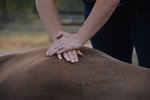

When Karen Stevens was 17 a veterinarian told her and her mom there was nothing to be done about one of their horses and he needed to be put down.
Stevens’ mother decided she didn’t like or agree with that assessment.
“You don’t tell my mom that you have to put her hore down,” Stevens said.
Instead, they sought the opinion of a horse chiropractor. After a few adjustments, the horse was back to normal.
That experience, seeing how much of an impact chiropractics can have on an animal, stayed with Stevens and it’s the first thing she talks about when asked what prompted her to pursue a practice in animal chiropractics, over 30 years later.
Stevens was born and raised in Battle Ground and was fully immersed in its rich equestrian culture as a youth: she showed horses as a Saddle Club member and was named both Clark County Fair Equestrian Queen and Vancouver Days Rodeo Queen.
After high school she worked for a time in the health and vehicle industries, then began to contemplate the idea of becoming a chiropractor. When a few of her cousins, who breed and raise dogs found out, they encouraged her to seek certification for animal chiropractors as well.
Stevens said as her cousins talked more about the importance of and need for animal chiropractors, it helped grow the seed that was planted three decades earlier. When it was time to pick her school, she made sure there was an animal chiropractic school close by.
That turned out to be Cleveland Chiropractic in Kansas City and Options for Animals in Wellsville, Kansas, 35 miles. She trained to adjust both humans and animals at the same time by driving between schools. When she moved back to the Pacific Northwest to finish her training at the University of Western State in Portland, she flew back to Kansas five times to complete her training in animal chiropractics.
Horses, dogs, a lot of pigs and a crooked chicken
Stevens has been at work in Clark County for about a year-and-a-half.
She does her two-legged adjustments at Synsvoll Chiropractic in Battle Ground and hits the road, making house calls all across Clark and into Cowlitz counties to adjust her four-legged clients back into place.
There are only a handful of animal chiropractors in the area and even fewer that do horses, which keeps Stevens busy. She sees anywhere from two to 10 animals a week.
During Stevens’ first summer in Clark County last year, the animal she treated most often was pigs. This summer has seen equal parts pigs, dogs and horses, and she even adjusted a chicken recently.
“I honestly didn’t think I did anything for the chicken,” she mused. “But the next day the lady walked into my human practice and said ‘we have a chicken miracle.’”
The one animal who gives her the most trouble? Cats.
Horses, dogs and even pigs get to know her after one visit. One dog she works on will turn around and back up to her when she arrives, ready for an adjustment. A horse she routinely services will drop its head when she walks near, knowing that she’s there to help. But not cats. They have no interest in seeing her again or even pretending to recognize her.
“Cats are just different,” she said.
Although cats can sometimes be a pain to work with (literally and figuratively, according to Stevens), she said her passion is to relieve the pain for those who can’t speak for themselves. Along with animals, she also enjoys working with babies.
“Babies are honestly just as rewarding as animals,” she said, adding “when you can make constipated baby poop, there’s really nothing better — the parents love you forever.”
Horses: what to look for
Stevens said adjustment needs can be especially apparent among barrel racing horses.
“If they dive into the first barrel instead of circle it, they need an adjustment,” she said.
One of the most glaring signs that a horse needs an adjustment is irritation when a saddle is thrown on their back.
Stevens said a lot of times a horse owner will think their horse is being ornery when they put a saddle on them, while in reality, the horse needs to be adjusted. Stevens said to watch for a horse throwing its head up and down and obvious signs such as limping.
“If every time they put a saddle on the horse, the horse is irritated, it needs to be adjusted,” she said.